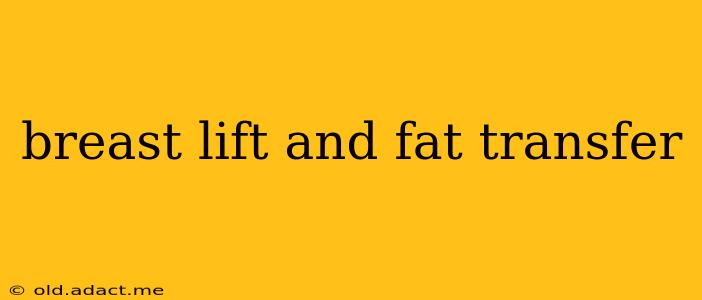A breast lift, or mastopexy, and fat transfer are two procedures that can enhance breast appearance, but they address different concerns and can be combined for optimal results. This guide explores both procedures individually and as a combined approach, answering frequently asked questions to provide a comprehensive understanding.
What is a Breast Lift?
A breast lift is a surgical procedure designed to lift and reshape the breasts, improving their position and overall appearance. Gravity, pregnancy, breastfeeding, and significant weight fluctuations can cause the breasts to sag, lose volume, and appear deflated. A breast lift addresses these issues by removing excess skin and repositioning breast tissue, resulting in a more youthful and perky appearance. The technique used varies depending on the degree of sagging and the patient's individual needs. Some procedures involve removing excess skin and repositioning the nipple, while others may involve reducing the size of the areola.
What is a Fat Transfer to the Breasts?
A fat transfer, also known as autologous fat grafting, involves harvesting fat from one area of the body (commonly the abdomen, thighs, or hips) and injecting it into the breasts to increase volume. This procedure offers a natural way to augment the breasts, as it uses the patient's own tissue. The fat is processed to remove impurities before being carefully injected into the breasts to create a more fuller and shapely appearance. It’s important to note that not all transferred fat survives, so multiple procedures may be necessary to achieve the desired results.
What are the Benefits of Combining a Breast Lift and Fat Transfer?
Combining a breast lift with a fat transfer offers several advantages, creating a more comprehensive and natural-looking outcome:
- Improved Breast Shape and Volume: A breast lift addresses sagging, while a fat transfer simultaneously adds volume, resulting in a more youthful and fuller breast appearance. This combined approach often provides superior results than either procedure alone.
- Natural Results: Using your own fat for augmentation offers a natural look and feel, reducing the risk of implant-related complications.
- Reduced Scarring (Potentially): While scars are inherent to a breast lift, strategically combining it with fat transfer may allow for less extensive skin removal, potentially minimizing scarring.
How is a Breast Lift with Fat Transfer Performed?
The procedure typically involves two stages. First, liposuction is performed to harvest fat from the donor site. The fat is then processed and prepared for injection. Simultaneously, or in a separate surgical phase, the breast lift procedure is performed. The surgeon will then carefully inject the purified fat into the breasts, strategically placing it to enhance the shape and volume.
What is the Recovery Process Like?
Recovery involves some discomfort, bruising, and swelling, which typically subside within a few weeks. Patients should expect some limitations in activity during the initial recovery phase. Specific instructions regarding post-operative care will be given by the surgeon. A follow-up appointment is crucial to monitor healing and assess the results.
What are the Risks and Complications?
As with any surgical procedure, there are potential risks associated with a breast lift and fat transfer, including infection, bleeding, asymmetry, fat necrosis (fat death), and poor fat engraftment. It's crucial to have a thorough consultation with a qualified and experienced plastic surgeon to discuss the risks and potential benefits.
How Much Does a Breast Lift with Fat Transfer Cost?
The cost varies widely depending on factors such as the surgeon's fees, the facility, anesthesia costs, and geographical location. It is best to contact several qualified plastic surgeons in your area to obtain accurate cost estimates.
How Long Do the Results Last?
The results of a breast lift are generally long-lasting, although the degree of improvement may gradually diminish over time due to aging and gravitational effects. The longevity of the fat transfer results depends on the survival rate of the grafted fat. While some fat may be reabsorbed, a significant portion typically remains for several years, potentially requiring touch-up procedures for lasting results.
Is a Breast Lift with Fat Transfer Right for Me?
This procedure is not suitable for everyone. A thorough consultation with a plastic surgeon is crucial to determine candidacy. The surgeon will assess your individual needs and expectations, discuss the risks and benefits, and help you determine if this combined procedure is the best option for you. It is vital to have realistic expectations and to choose a board-certified plastic surgeon with experience in these procedures.
This comprehensive guide offers a detailed overview of breast lift with fat transfer. Remember, this information should not substitute for a consultation with a qualified medical professional. Always consult your physician or a board-certified plastic surgeon to discuss your individual needs and suitability for this procedure.
